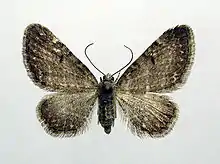Eupithecia valerianata
Eupithecia valerianata, the valerian pug, is a moth of the family Geometridae. The species was first described by Jacob Hübner in 1813. It is found from Great Britain, through central Europe to western Russia, Belarus and northern Iran.[3]
| Eupithecia valerianata | |
|---|---|
 | |
 | |
| Scientific classification | |
| Kingdom: | Animalia |
| Phylum: | Arthropoda |
| Class: | Insecta |
| Order: | Lepidoptera |
| Family: | Geometridae |
| Genus: | Eupithecia |
| Species: | E. valerianata |
| Binomial name | |
| Eupithecia valerianata | |
| Synonyms | |
| |
The wingspan is 16–20 mm. The ground colour of the forewings is brownish grey. The darker-coloured crosslines are faint. There is a pale, dentate subterminal line (sometimes incomplete). The forewings have a dark discal mark (sometimes grey, indistinct or absent). The hindwings are pale whitish brown and there is a tornal spot.[3]
There is one generation per year with adults on wing from mid-April to August.
Eupithecia valerianata inhabits wet meadows, ditch edges, forest edges and other locations where Valeriana species grow.
The larvae feed on Valeriana species. Larvae can be found from June to September. It overwinters as a pupa.
References
- Eupithecia valerianata at Fauna Europaea
- Yu, Dicky Sick Ki. "Eupithecia valerianata (Hubner 1813)". Home of Ichneumonoidea. Taxapad. Archived from the original on 25 March 2016.
- Eupithecia valerianata full description Watson, L., and Dallwitz, M.J. 2003 onwards. British insects: the genera of Lepidoptera-Geometridae. Version: 29 December 2011
| Wikimedia Commons has media related to Eupithecia valerianata. |
External links
- Kimber, Ian. "70.181 BF1821 Valerian Pug Eupithecia valerianata (Hübner, [1813])". UKMoths. Retrieved 30 June 2019.
- Lepiforum e.V.